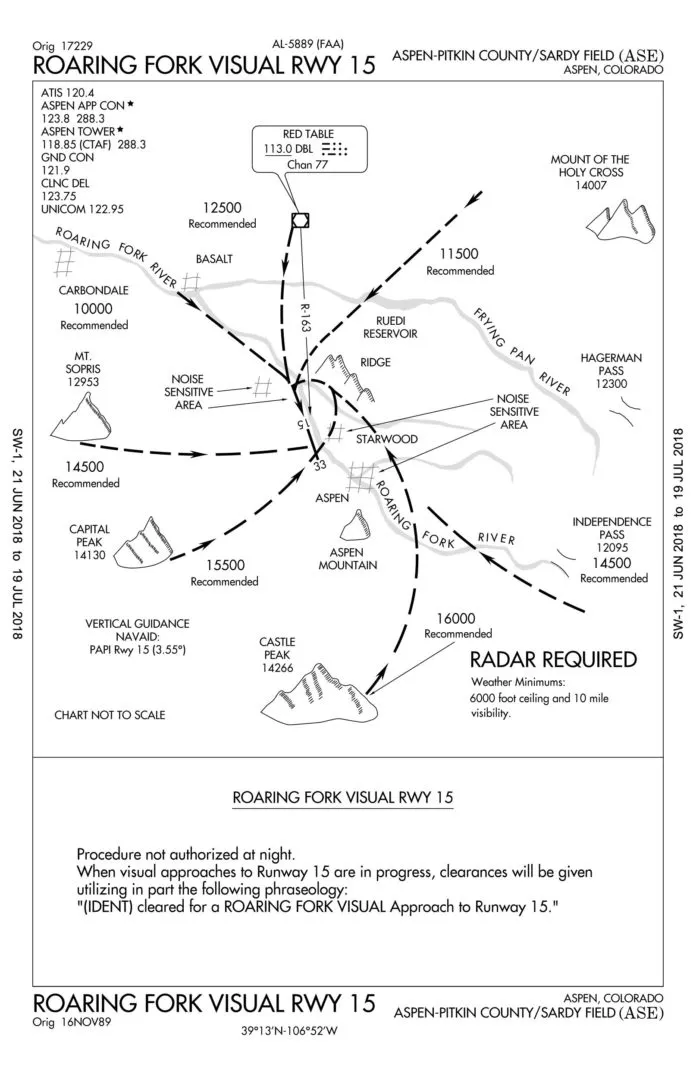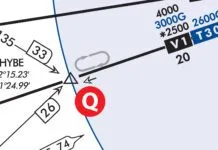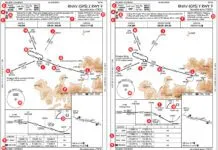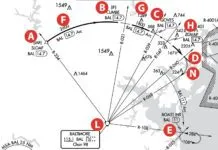Wedged between normal and CFIT flight sits another layer, the precursor to a CFIT accident, called Controlled Flight Toward Terrain, or CFTT. If we can avoid CFTT conditions, we can surely prevent deadly CFIT accidents. Our purpose here is to educate and sensitize the pilot community to the concept of CFTT using examples from the Aviation Safety Reporting System database.
IFR separation from other aircraft is well-understood in our community. Within the controller community there is something additional called terrain separation. A loss of terrain separation occurs when an aircraft enters a chunk of airspace at an altitude below the prescribed minimums. Minimum vectoring (or instrument) altitudes aren’t published, so initially they’re the controller’s responsibility. Busting either is CFTT, but they are not the sole province of ATC. Pilots also cause CFTTs. Let’s look in our own house first.
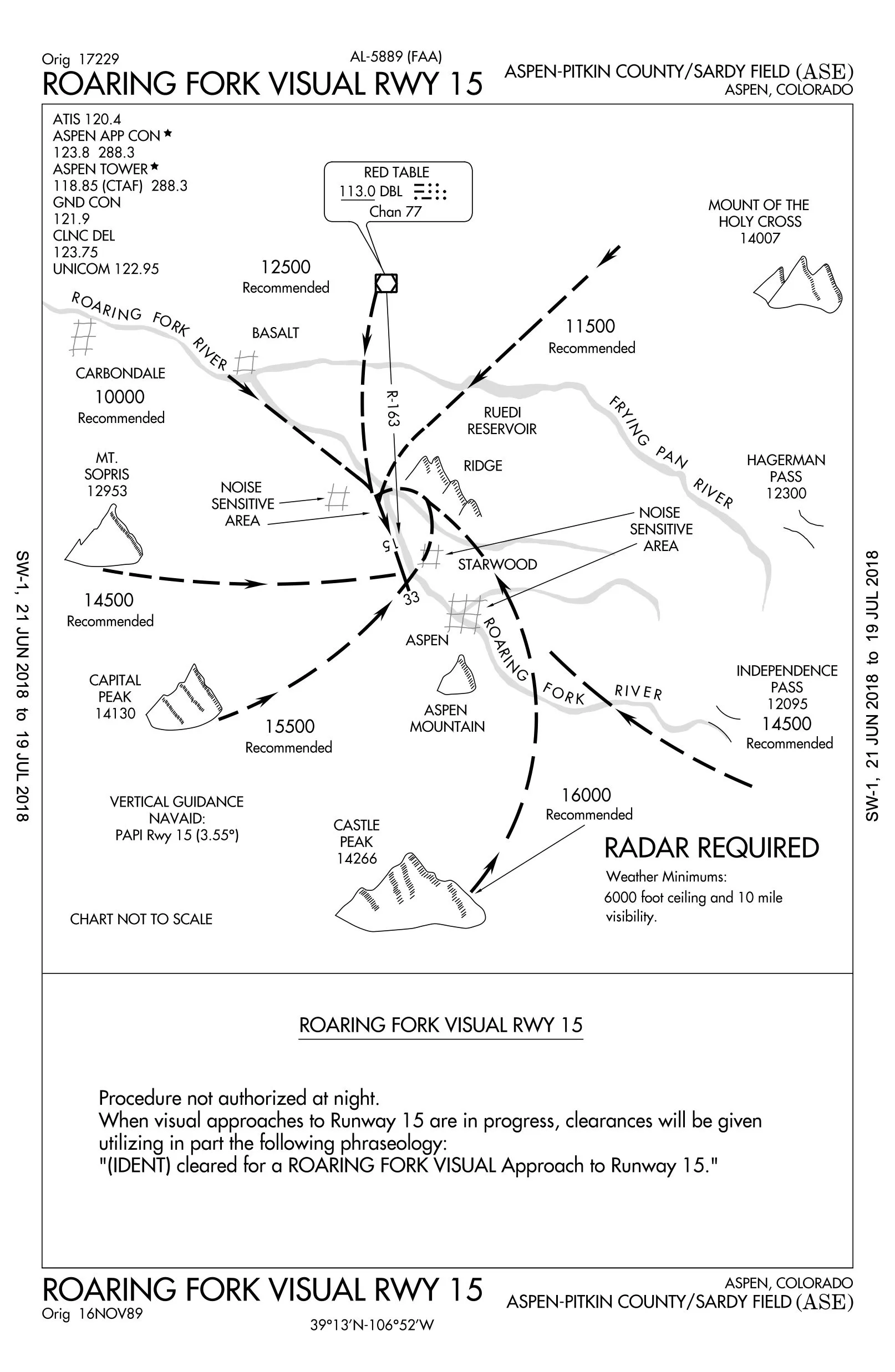
Roaring Forks
Flying the Roaring Fork Visual RWY 15 into Aspen, CO, a corporate jet captain was surprised to hear several “Terrain Pull-Up” calls. Over the highway, in the valley and at about 9100 feet (about 900 feet low) he was four to five miles from the runway. Rather than go around and initiate an escape procedure per the Flight and Operations Manuals, he elected to climb, get back on normal glide path and save the approach.
Later, he admitted that he allowed his desire to accomplish the mission and “make it work” override his better judgment. He failed to realize that the cumulogranite was a real threat. He further felt that he should have never let things go that far. At the first sign of uncertainty as to the airport’s location by the copilot, he should have bailed on the approach at altitude. Yet he allowed his familiarity and confidence with the tricky approach to slide into a sense of complacency that put everyone aboard at risk. Who among us has not tried to salvage a bad approach?
Buffaloed in Burbank
A piston-twin pilot was flying IFR into Burbank, CA (KBUR). The weather was VMC with five to seven miles’ visibility. SOCAL Approach seemed to want him to shoot an approach, apparently since the airport is “near a lot of big hills.” The pilot requested a visual approach because he was uncomfortable flying an instrument approach he did not expect to need and hence had not briefed, especially into an unfamiliar airport.
The cure perhaps proved worse than the ill. Twice he descended 500 feet below his assigned 3000-foot altitude, and ATC called an altitude alert. He believed the reason was that the autopilot was in attitude mode, not in ALT (Altitude Hold). He attributed his error to stress, unfamiliarity with the published visual approach and being unable to retrieve it on his iPhone or iPad which had overheated. Apparently, he did not set ALT until reaching 3000 feet again. He was subject to getting a pilot deviation for failing to maintain altitude.
Two Views, Same Flight
The narratives below represent those of the controller and the pilot. First, from the NORCAL TRACON controller:
Controller Perspective
The IFR Skylane was cleared for an RNAV approach to a nontower airport, given cancellation instructions and switched to advisory frequency. On short final, ATC saw the aircraft turn left as if to fly the published missed approach. The Low Altitude Alert on his radar began flashing. He called the Skylane—no answer.
The Skylane continued turning eastward, foiling the missed approach theory. Calling again, the pilot said he was “trying to get back on top.” ATC told him to fly present heading, climb and maintain 3000 feet. The aircraft was at 1000 feet, inside a 2300-foot MVA. The controller later regretted not issuing a safety alert instructing an immediate climb. The Skylane’s left turn continued, so the controller reissued his instructions. It seemed clear that the pilot was spiraling to get on top although the controller did not seem to realize this. The controller was trying to help the pilot get above the layer, even giving him a vector below MVA, which he wasn’t supposed to do.
The controller obtained pilot reports that nearby airports were clear. Once the pilot was back on top, he gave him weather and PIREPs. The pilot decided to land at a tower airport. Accordingly, the controller recleared him and coordinated with the tower to arrange a visual approach from which the pilot landed safely.
The controller lamented that he needed to make sure he issued the correct safety alerts. He felt the pilot was in distress and treated him as an emergency even though the pilot did not declare one. The controller was trying to understand what he was seeing, which put his judgment “a little bit behind.”
Pilot Perspective
Established on the RNAV approach inside the FAF, the aircraft was stabilized and flying in clouds with autopilot engaged. The ceiling was about 1200 feet and there was VFR traffic in the pattern landing on Runway 20. Being over the ocean, the ceiling was lower than at the airport with essentially no visibility. Since the RNAV approach opposed pattern traffic, the pilot monitored Approach and CTAF and made position reports approaching the airport.
The 182 had recently been upgraded with an Aspen Evolution 1000 Pro glass panel including a flight director. The AP/FD switch was installed in a poor location that allowed inadvertent disconnection of the autopilot. Apparently, he bumped that switch, disconnecting the autopilot. The autopilot sounded the aural disconnect warning, startling the pilot who lost control of the airplane, beginning a turn and continuing to descend. Once he regained control he was off course, shaken up, and just wanted to get on top. He started a spiral climb. Climbing straight ahead would have been safer as the controller instructed. That would have reduced the prospect of another loss of control, but his mind was rattled.
Once the pilot was on top but still shaken, the controller directed him to a VFR airport where he landed. He realized that he needed more help transitioning to the new avionics. He thought he could handle the transition alone, but he was clearly mistaken. He needed help to develop a better IMC scan and in dealing with unexpected problems in IMC. He scheduled time with his CFII to address these issues.
He received a pilot deviation from the published missed approach and flight below MVA. We can hope that the pilot admitting his error and forming a corrective plan sat well with Flight Standards in this modern era of compliance philosophy.
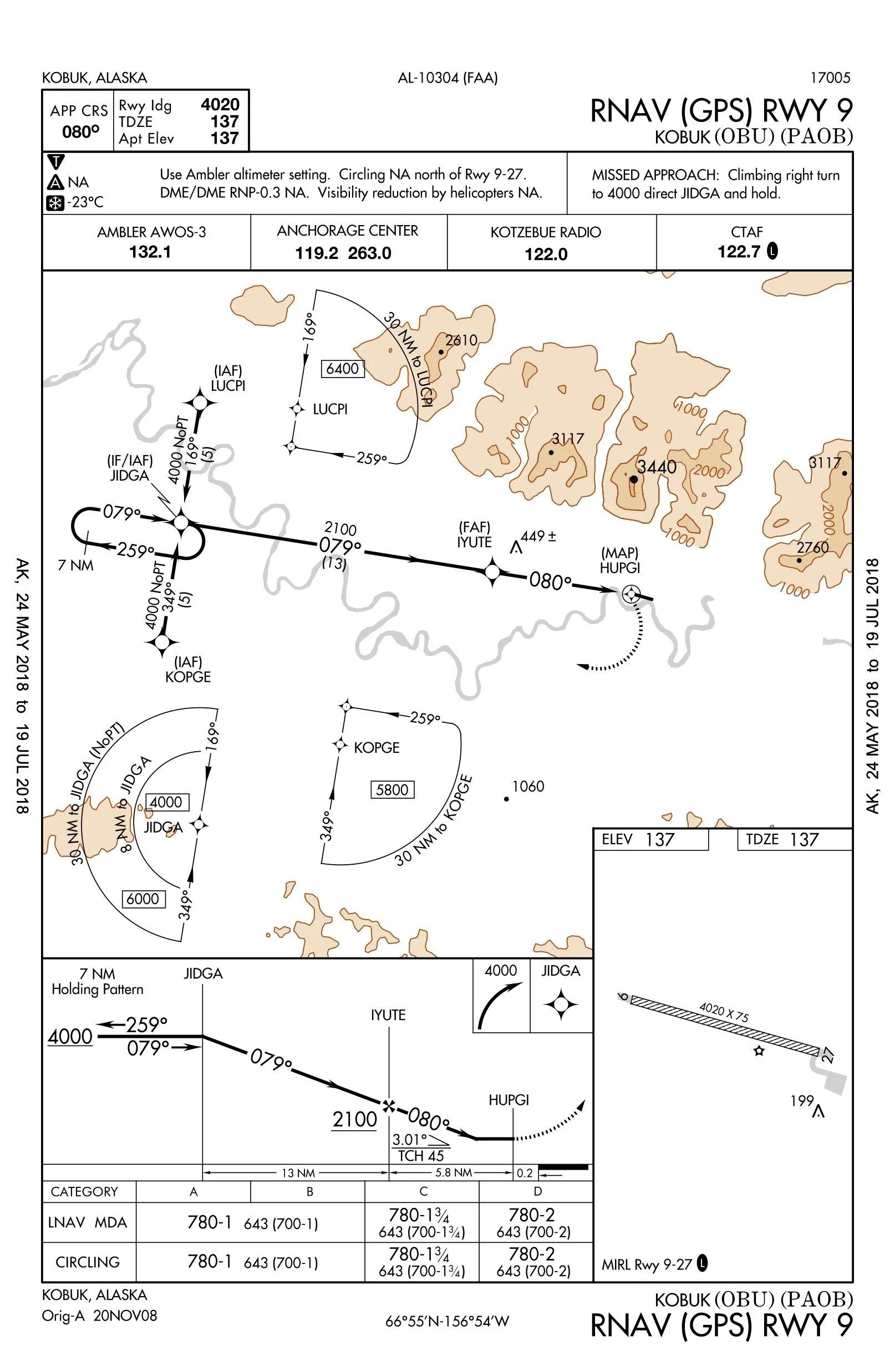
Too Low at OBU
The pilot of a light twin was flying his first approach into Kobuk Airport, OBU, in northwest Alaska. Knowing this, he briefed the RNAV (GPS) RWY 9 approach twice en route northbound to KOPGE at 7000 feet. ATC cleared him for the approach 70 NM south of KOPGE because there is nominally no radar or center radio coverage in that area. Fixated on the JIDGA IAF and the initial approach altitude of 4000, the pilot descended to 4000 feet within 30 NM of KOPGE.
Oops! An airliner relayed a call from ATC that an altitude alert appeared on the controller’s radar and requested he climb back to 6000 feet. Speaking afterward with Center, the pilot realized that he had fixated on JIDGA and descended too early. He simply got too far ahead of himself. He could only descend to 4000 within eight, not 30, miles from JIDGA.
MIA
An IFR twin pilot contacted Salt Lake Center requesting a destination change. The controller immediately cleared him direct to his desired airport at 10,000 feet. The pilot stumbled slightly on his readback, adding something unreadable at the end. Thinking it involved the diversion, the controller asked him to say again the last part. The pilot said he had a left alternator issue. The controller offered further assistance, but the pilot declined.
When the controller tried to communicate NOTAMS and have the pilot report receipt of the weather, there was no response. Eventually the aircraft descended to 9500 feet, below the assigned 10,000-foot minimum. The controller assumed the pilot had the field in sight and was commencing his approach, dropping below radio coverage. However, the pilot later responded and said he had been off-frequency (without ATC permission) listening to weather. The controller restated his assigned altitude and he complied. Reviewing the tape afterward, the pilot had not read back his assigned altitude when initially cleared and the controller missed it.
In the controller’s words, the only read back technically required of a pilot is to read back a hold short clearance. The legal language says pilots “should” read back altitude assignments. Fine print or no, he should question when a pilot does not. The controller can request a readback, which he should have done. The result was an altitude bust.
AirVenture or Bust
The CFI tried unsuccessfully to get an IFR reservation into KOSH. He then obtained a reservation to nearby Portage Municipal Airport, where he would shoot its lone RNAV approach, land and wait for OSH weather to go VFR and then continue visually via the Fisk VFR Arrival.
He broke out at 1400 feet MSL and elected to continue to KOSH. But it was sketchy, with ragged cloud bases less than a hundred feet overhead. He navely rationalized this was all right because of the “special circumstances” of AirVenture procedures at OSH. Barely clear of cloud and as low as 400-500 feet AGL, conditions improved, and he landed safely.
The pilot later realized the serious risk he took in scud-running so low, in effect creating his own brand of Special VFR, and that his illogical rationalizing had nearly cost him his life. Was AirVenture worth that?
Not Just Pilots
ATC cleared an aircraft down to 3000 feet. At 3150 feet, ATC advised the pilot to maintain 3500, the controller’s minimum vectoring altitude (MVA). The controller acknowledged the previous error.
Another controller descended an aircraft to 2700 feet where the MVA was 2900 feet due to an antenna. He said, “at his rate of descent they always clear that antenna.” His assumption proved false as the aircraft descended rapidly. He thought “it would help if pilots told us they were doing a nonstandard rate of descent. I think I will never anticipate a standard rate again.”
A pilot was instructed to turn left but turned right. The controller issued “no delay climb to 7100,” the MVA. The aircraft clipped its edge climbing through 6700 feet. The controller stated that his multiple and contradictory heading changes confused the pilot into turning the wrong way.
An RV-7 at 7000 feet was joining an airway whose MEA was 10,000 feet. He requested and received clearance to climb. Soon ATC noticed the RV-7’s climb rate had decreased. The controller estimated that he entered an 8700-foot MVA below 8700 feet based on climb rate. He should have vectored the RV-7 to keep him above a 6400-foot MVA until he was sure it could top the 8700-foot MVA and then vector him to rejoin the airway.
A TRACON controller misidentified aircraft with similar-sounding call signs and issued a descent and heading to an aircraft below MVA and into conflict with departing traffic. Another TRACON controller reported a missed readback which nearly led an aircraft to descend below MVA. An incorrect and blocked readback led another aircraft to bust a 13,000-foot MIA near Washington’s Glacier Peak. A clearance down to 6000 and a speed request of 190 knots was read back as “60 to a 190.” The pilot turned to 190 degrees—straight into a 7900-foot MVA.
Rarely, MVA busts occur at an airport when there is nowhere else to go. A San Diego tower controller sent an aircraft around, which then forced him to stop a departure’s climb below MVA to maintain separation. A Honolulu TRACON supervisor reported that two aircraft departed HNL on nearly identical headings. One aircraft was stopped below MVA at 2000 feet to allow another’s climb to 4000. However against the rules, it’s less risk sending an airplane into an MVA rather than into a mid-air collision.
Takeaways
Most MVA busts are by pilots, but controllers are not immune. The prime cause is poor communication: errors in pilot readbacks; controllers missing them during hearbacks. There may be a blocked or no readback or nonstandard phraseology: “60 to a 190.”
Some MVAs are questionable. Surrounding Anchorage, AK, there are 6000-8000 feet MVA’s over sea level water. If we get vectored into an MVA, let’s hope it’s at least over a pond.
When teaching in Florida, Fred Simonds, CFII, listens carefully, always reads back completely, and hasn’t (yet) gotten too close to the terrain. See his web site atFredOnFlying.com.

